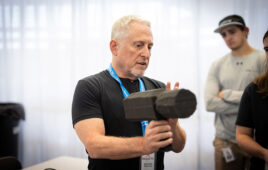 An experiment led by the Univ. of Colorado Boulder arrived at the International Space Station (ISS) on Friday, April 17, 2015, and will look into the fluid dynamics of liquid crystals that may lead to benefits both on Earth and in space.
An experiment led by the Univ. of Colorado Boulder arrived at the International Space Station (ISS) on Friday, April 17, 2015, and will look into the fluid dynamics of liquid crystals that may lead to benefits both on Earth and in space.
A new physical science investigation on ISS, the Observation and Analysis of Smectic Islands in Space (OASIS), will examine the behavior of liquid crystals in microgravity, said CU-Boulder physics Prof. Noel Clark, principal investigator on the experiment. Specifically, the research team is observing the overall motion and merging of microscopic layers that form “smectic islands” on the surface of bubbles. The investigation may shine light on how microgravity affects the properties of liquid crystals.
Liquid crystals are used in television and laptop screens, cellphones and a variety of other electronics with flat panel displays.
“OASIS is the first study of smectic liquid crystal materials in microgravity, and may well be the first study of any liquid crystal material in microgravity,” said Clark. The OASIS experiment will take place in the Microgravity Science Glovebox onboard ISS, which enables a wide range of experiments in a fully sealed and controlled environment.
Clark heads the Soft Materials Research Center (SMRC) headquartered on campus, one of 12 Materials Research and Science Engineering Centers selected by the National Science Foundation for renewed funding in February 2015. The CU-Boulder center will be supported by a $12 million NSF grant over six years.
While OASIS is focused on basic physical phenomena, the findings may have a long-term impact on technology and human health. Most living things either are or once were in a liquid crystal state, and all biological liquid crystals are formed by aggregates of molecules in a solvent, like water, said Clark. Perhaps the most important example of a biological liquid crystal is the cell membrane.
“Since many of the processes critical for the life of the cell take place in the plasma membrane or in the membranes of organelles, the physics of transport, diffusion and aggregation of particles in thin, fluid membranes is of fundamental interest, with clear relevance to the life sciences,” Clark said.
Source: Univ. of Colorado, Boulder
ENTRIES OPEN:
Establish your company as a technology leader. For 50 years, the R&D 100 Awards, widely recognized as the “Oscars of Invention,” have showcased products of technological significance. Learn more.




